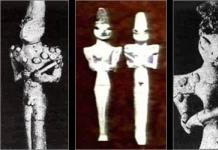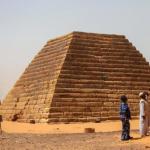Zecharia Sitchin was born on July 11, 1920 in the city of Baku, the capital of young Soviet Azerbaijan. He grew up in Palestine, where his parents moved. There Zechariah received knowledge in the field of modern and ancient Hebrew, other Semitic and European languages, as well as the Old Testament, the history and archeology of the Middle East.
Later he graduated from the London School of Economics and the University of London. But the main interest in Sitchin’s life was ancient history, to which he gave very unique interpretations. Having worked for many years as a journalist and editor in Israel, Zachariah later lived and worked in New York
Few could compare with this man in knowledge of ancient languages. One of the few linguists able to read Sumerian cuneiform texts, he was also considered an authority on Hebrew and Egyptian hieroglyphics. But Sitchin’s unusual method of interpreting ancient texts still raises numerous objections from people of science. Regardless of whether the texts in question are biblical, Sumerian, ancient Egyptian, or other, Zechariah insisted that they should not be taken allegorically, like myths, but literally, like modern journalism. “If someone says that a group of 50 people landed in the Persian Gulf under the leadership of Enki,” he argued, “and waded to the shore, built a settlement, then why should I say that this never happened, that this is a metaphor , a myth, an imagination, that someone just made this up.”
Those who created people
Beginning with The Twelfth Planet, published in 1976, Zecharia Sitchin developed his unique interpretation of ancient texts. In the end, it developed into an extensive and fascinating story, which could well serve as the plot of more than one science fiction film. But, according to the writer, these are exactly the events that actually happened at the dawn of humanity. Sitchin proves that there is another planet in the solar system, extremely distant from the star and moving in an elongated ellipsoidal orbit - Nibiru, or otherwise Marduk. The period of its rotation around the Sun is about 3600-3760 years. From there, in ancient times, paleoastronauts came to Earth - the biblical giants, or Anunnaki, who were described by the Sumerians as humanoid creatures three and a half to five meters tall with a lifespan of up to 360 thousand years.
It was the creatures from Nibiru who artificially created modern humanity, using genetic engineering by combining their genes with the genes of Homo erectus - Homo erectus, or, more simply, Pithecanthropus. Sitchin developed this hypothesis in a whole series of books: “Stairway to Heaven”, “Wars of Gods and Men”, “Lost Worlds” and “When Time Begin”. The texts of the series received the general title “Chronicles of the Earth” and were supplemented by another work, “Revisited Genesis.” The researcher found confirmation of his ideas in the materials of the International Consortium for Sequencing (Deciphering) the Human Genome, which discovered in this very genome 223 unique genes, which, as it seemed at first, had no predecessors in evolution. But the further the work of the consortium went, the more and more biologically plausible explanations were given for the identified paradoxes. In particular, it turned out that about 40 of these mysterious genes were inherited by humans from the so-called prokaryotes - single-celled living organisms that do not have a formed cell nucleus, that is, bacteria. After all, these tiny creatures reigned supreme on our planet 3.6-1.6 billion years ago.
From the fragments of Tiamat
The Sumerians' ideas about the origin of the Universe were that, in their opinion, then only water existed and terrible chaos reigned. From it the first gods were born. Over time, some gods wanted to establish order in the universe. This caused the indignation of the god Abzu and his wife Tiamat, the goddess of chaos, the mother of all dragons. But the adherents of order united under the leadership of the wise god Ea and killed Abzu. Tiamat decided to take revenge for the death of her husband. Then the rebels, led by Marduk, defeated the goddess of chaos in a bloody battle, and her gigantic body was cut into two parts, of which one part became the earth, and the other became the sky. The blood of Abzu was mixed with clay, and from this mixture the first man appeared.
In Sitchin's interpretation, Tiamat appears to be a large planet that formed after the formation of the Solar System and moved in the orbit of the current asteroid belt. After a collision with the satellite of Marduk, the planet was split into two halves. During the next passage through the inner regions of the Solar System, Nibiru-Marduk itself collided with one of the halves of the “goddess of chaos” and turned it into the asteroid belt. The second part of Tiamat, after a “meeting” head-on with another satellite of Nibiru, fell into a new orbit, where it is now found under the name “Earth”. Despite the fact that scientists are convinced that such a scenario is impossible, supporters of Sitchin’s hypothesis are confident that it explains the reason for the separation of continents on our planet and the nature of the layers in sedimentary rocks. Confirmation of the rightness of the American writer is also found in the fact that the continents of the Earth are concentrated on one side of it, and on the other there is a huge ocean.
Kidnapped by the Gods
Sitchin's book "Divine Aliens" retells stories from biblical, Sumerian and Egyptian sources, from the Garden of Eden to Gilgamesh, in accordance with the theory of paleocontact. The writer is convinced that all references to deities actually point to the Anunnaki, and does not distinguish between modern cases of abductions of earthlings by aliens and the same actions by paleo-astronauts. Emphasizing that he was never personally kidnapped, Sitchin points out that while in our time such an experience is seen as negative, associated with painful experiences, then “in ancient times, joining the deities was a great and unique privilege. Only a few have been honored with this.”
Descendants from close contacts between people and deified aliens were perceived in ancient times as demigods. The Bible, according to Zecharia Sitchin, clearly states that the Anunnaki chose their wives from the daughters of man and had children from them, as a rule, very prominent personalities. Similar demigods are described in Mesopotamian literature, and in ancient Egyptian mythology, and, to a certain extent, in ancient Greek sources. After all, the same Alexander the Great believed that the sons of the gods entered into relationships with his mother.
Older than the Anunnaki?
The argument that the Sumerian and Egyptian civilizations had an extraterrestrial source does not rule out, for Sitchin, the likely presence of earlier and perhaps more advanced cultures on Earth. In these conclusions, he builds on Sumerian and Assyrian legends. King Ashurbanipal, for example, said that he could read texts dating back to antediluvian times, and talked about cities and people destroyed by a global cataclysm. So for the researcher, only a firm “yes” becomes the answer to the question about the existence of an unknown civilization before the Sumerians and even before the Great Flood.
Zecharia Sitchin and the works of the ancient Greek philosopher Plato take the works of the ancient Greek philosopher Plato just as literally as Mesopotamian and Egyptian mythologies, although he emphasizes that he somewhat confusingly points to the location of Atlantis. “Was it in the middle of the Atlantic Ocean, in the Pacific Ocean, which later became known as My, or in Antarctica? It is not clear what of the above [Plato] is actually reporting. But no questions arise - once upon a time there was a certain civilization that was destroyed or disappeared as a result of a terrible catastrophe, the Great Flood or another similar phenomenon.”
Over the past two or three years, the media have been intensely whipping up hysteria about the end of the world in 2012. The scenario of this Armageddon arose from a bizarre symbiosis of the last date of the Mayan calendar and the myth of the planet Nibiru-Marduk.
In the leapfrog of arguments and counterarguments, it was somehow forgotten that the person thanks to whom the myth of Nibiru received a modern sound - the American researcher Zecharia Sitchin, who died in October 2010 - called a completely different date for the rapprochement of our planet and Marduk, namely 2085.
Zecharia Sitchin was born on July 11, 1920 in the city of Baku, the capital of young Soviet Azerbaijan. He grew up in Palestine, where his parents moved. There Zechariah received knowledge in the field of modern and ancient Hebrew, other Semitic and European languages, as well as the Old Testament, the history and archeology of the Middle East. Later he graduated from the London School of Economics and the University of London. But the main interest in Sitchin’s life was ancient history, to which he gave very unique interpretations. After working for many years as a journalist and editor in Israel, Zachariah later lived and worked in New York.
Few could compare with this man in knowledge of ancient languages. One of the few linguists able to read Sumerian cuneiform texts, he was also considered an authority on Hebrew and Egyptian hieroglyphics. But Sitchin’s unusual method of interpreting ancient texts still raises numerous objections from people of science.
Whether the texts were biblical, Sumerian, ancient Egyptian, or other, Zechariah insisted that they should not be taken allegorically, like myths, but literally, like modern journalism. “If someone says that a group of 50 people landed in the Persian Gulf under the leadership of Enki,” he argued, “and waded to the shore, built a settlement, then why should I say that this never happened, that this is a metaphor?” , myth, imagination, that someone just came up with this.
Those who created people
Beginning with The Twelfth Planet, published in 1976, Zecharia Sitchin developed his unique interpretation of ancient texts. In the end, it developed into an extensive and fascinating story, which could well serve as the plot of more than one science fiction film. But according to the writer, these are precisely the events that actually took place at the dawn of humanity.
Sitchin proves that there is another planet in the solar system, extremely distant from the star and moving in an elongated ellipsoidal orbit - Nibiru, or otherwise - Marduk. The period of its rotation around the Sun is about 3600-3760 years. From there, in ancient times, paleoastronauts came to Earth - the biblical giants, or Anunnaki, who were described by the Sumerians as beings three and a half to five meters tall with a lifespan of up to 360 thousand years.
It was the creatures from Nibiru who artificially created modern humanity, using genetic engineering by combining their genes with the genes of Homo erectus - Homo erectus, that is, Pithecanthropus. Sitchin developed this hypothesis in a whole series of books: “Stairway to Heaven”, “Wars of Gods and Men”, “Lost Worlds” and “When Time Begin”. The texts of the series received the general title “Chronicles of the Earth” and were supplemented by another work, “Revisited Genesis.”
The researcher found confirmation of his ideas in the materials of the International Consortium for Sequencing (Deciphering) the Human Genome, which discovered in this very genome 223 unique genes, which, as it seemed at first, had no predecessors in evolution. But the further the work of the consortium went, the more biologically plausible explanations were given for the identified paradoxes. In particular, it turned out that about 40 of these mysterious genes were inherited by humans from so-called prokaryotes - single-celled living organisms that do not have a formed cell nucleus, that is, bacteria. After all, these tiny creatures reigned supreme on our planet 3.6 -1.6 billion years ago.
From the fragments of Tiamat
The Sumerians' ideas about the origin of the Universe were that, in their opinion, then only water existed and terrible chaos reigned. From it the first gods were born. Over time, some gods wanted to establish order in the universe. This caused the indignation of the god Abzu and his wife Tiamat, the goddess of chaos, the mother of all dragons. But the adherents of order united under the leadership of the wise god Ea and killed Abzu. Tiamat decided to take revenge for the death of her husband. Then the rebels, led by Mardun, defeated the goddess of chaos in a bloody battle, and her gigantic body was cut into two parts, of which one part became the earth and the other the sky. The blood of Abzu was mixed with clay, and from this mixture the first man appeared.
In Sitchin's interpretation, Tiamat appears to be a large planet that formed after the formation of the Solar System and moved in the orbit of the current asteroid belt. After a collision with the satellite of Marduk, the planet was split into two halves. During the next passage through the inner regions of the Solar System, Nibiru-Marduk itself collided with one of the halves of the “goddess of chaos” and turned it into the asteroid belt. The second part of Tiamat, after a “meeting” head-on with another satellite of Nibiru, fell into a new orbit, where it is now found under the name “Earth”. Despite the fact that scientists are convinced that such a scenario is impossible, supporters of Sitchin’s hypothesis are confident that it explains the reason for the separation of continents on our planet and the nature of layers in sedimentary rocks. Confirmation of the rightness of the American writer is also found in the fact that the continents of the Earth are concentrated on one side of it, and on the other there is a huge ocean.
Kidnapped by the Gods
Sitchin's book "Divine Aliens" retells stories from biblical, Sumerian and Egyptian sources, from the Garden of Eden to Gilgamesh, in accordance with the theory of paleocontact. The writer is convinced that all references to deities actually point to the Anunnaki, and does not distinguish between modern cases of abductions of earthlings by aliens and the same actions by paleo-astronauts. Emphasizing that he was never personally kidnapped, Sitchin points out that while in our time such an experience is seen as negative, associated with painful experiences, then “in ancient times, joining the deities was a great and unique privilege. Only a few have been honored with this.”
Descendants from close contacts between people and deified aliens were perceived in ancient times as demigods. The Bible, according to Zecharia Sitchin, clearly states that the Anunnaki chose their wives from the daughters of men and had children from them, as a rule, very prominent personalities. Similar demigods are described in Mesopotamian literature, and in ancient Egyptian mythology, and, to a certain extent, in ancient Greek sources. After all, the same Alexander the Great believed that the sons of the gods entered into relationships with his mother.
Older than the Anunnaki?
The argument that the Sumerian and Egyptian civilizations had an extraterrestrial source does not rule out, for Sitchin, the likely presence of earlier and perhaps more advanced cultures on Earth. In these conclusions, he builds on Sumerian and Assyrian legends. King Ashurbanipal, for example, said that he could read texts dating back to antediluvian times, and talked about cities and people destroyed by a global cataclysm. So for the researcher, only a firm “yes” becomes the answer to the question about the existence of an unknown civilization before the Sumerians and even before the Great Flood.
Zecharia Sitchin and the works of the ancient Greek Plato take the works of the ancient Greek Plato just as literally as Mesopotamian and Egyptian mythologies, although he emphasizes that he somewhat confusingly points to the location of Atlantis. “Was it in the middle of the Atlantic Ocean, in the Pacific Ocean, which later became known as My, or in Antarctica? It is not clear what of the above [Plato] is actually talking about. But no questions arise - once upon a time there was a certain civilization that was destroyed or disappeared as a result of a terrible catastrophe, the Great Flood or another similar phenomenon.”
Over the past two or three years, the media have been intensely whipping up hysteria about the end of the world in 2012. The scenario of this Armageddon arose from a bizarre symbiosis of the last date of the Mayan calendar and the myth about the planet Nnbiru-Marduk.
In the leapfrog of arguments and counterarguments, it was somehow forgotten that the person thanks to whom the myth of Nibnru received a modern sound - the American researcher Zecharia Sitchin, who died in October 2010 - named a completely different date for the rapprochement of our planet and Marduk, namely: 2085.
Zechariah Sigchin born on July 11, 1920 in the city of Baku - the capital of young Soviet Azerbaijan, grew up in Palestine, his parents miraculously moved. There Zechariah received knowledge in the field of modern and ancient Hebrew, other Semitic and European languages, as well as the Old Testament, the history and archeology of the Middle East. Later he graduated from the London School of Economics and the University of London. But the main interest in Sitchin’s life was ancient history, to which he gave very unique interpretations. After working for many years as a journalist and editor in Israel, Zachariah later lived and worked in New York.
Few could compare with this man in knowledge of ancient languages. One of the few linguists able to read Sumerian cuneiform texts, he was also considered an authority on Hebrew and Egyptian hieroglyphics. But Sitchin’s unusual method of interpreting ancient texts still raises numerous objections from people of science.
Whether the texts are biblical, Sumerian, ancient Egyptian, or other, Zechariah insisted that they should not be taken allegorically, like myths, but literally, like modern journalism. “If someone says that a group of 50 people landed in the Persian Gulf under the leadership of Enki,” he argued. - and waded to the shore, built a settlement, so why should I say that this never happened, that this is a metaphor, a myth. imagination that someone just made it up.
Those who created people
Beginning with The Twelfth Planet, published in 1976, Zecharia Sitchin developed his unique interpretation of ancient texts. In the end, it developed into an extensive and fascinating story, which could well serve as the plot of more than one science fiction film. But according to the writer, these are precisely the events that actually took place at the dawn of humanity.
 Sitchin proves that there is another planet in the solar system, extremely distant from the star and moving in an elongated ellipsoidal orbit - Nibiru or otherwise, Marduk. The period of its rotation around the Sun is about 3600-3760 years. From there, in ancient times, paleoastronauts came to Earth - the biblical giants, or Anunnaki, who were described by the Sumerians as creatures three and a half to five meters tall with a lifespan of up to 360 thousand years.
Sitchin proves that there is another planet in the solar system, extremely distant from the star and moving in an elongated ellipsoidal orbit - Nibiru or otherwise, Marduk. The period of its rotation around the Sun is about 3600-3760 years. From there, in ancient times, paleoastronauts came to Earth - the biblical giants, or Anunnaki, who were described by the Sumerians as creatures three and a half to five meters tall with a lifespan of up to 360 thousand years.
It was the creatures from Nibiru who artificially created modern humanity, using genetic engineering by combining their genes with the genes of Homo erectus - Homo erectus, that is, Pithecanthropus. Sitchin developed this hypothesis in a whole series of books: “Stairway to Heaven”, “Wars of Gods and Men”, “Lost Worlds” and “When Time Begin”. The texts of the series received the general title "Chronicles of the Earth" and were supplemented by another work - "Revised Genesis".
The researcher found confirmation of his ideas in the materials of the International Consortium for Sequencing (Deciphering) the Human Genome, which discovered in this very genome 223 unique genes, which, as it seemed at first, had no predecessors in evolution. But the further the work of the consortium went, the more biologically plausible explanations were given for the identified paradoxes. In particular, it turned out that about 40 of these mysterious genes were inherited by humans from so-called prokaryotes - single-celled living organisms that do not have a formed cell nucleus, that is, bacteria. After all, these tiny creatures reigned supreme on our planet 3.6 -1.6 billion years ago.
From the fragments of Tiamat
The Sumerians' ideas about the origin of the Universe were that, in their opinion, then only water existed and terrible chaos reigned. From it the first gods were born. Over time, some gods wanted to establish order in the universe. This caused the indignation of the god Abzu and his wife Tiamat, the goddess of chaos, the mother of all dragons. But the adherents of order united under the leadership of the wise god Ea and killed Abzu. Tiamat decided to take revenge for the death of her husband. Then the rebels, led by Mardun, defeated the goddess of chaos in a bloody battle, and her gigantic body was cut into two parts, of which one part became the earth and the other the sky. The blood of Abzu was mixed with clay, and from this mixture the first man appeared.
In Sitchin's interpretation, Tiamat appears to be a large planet that formed after the formation of the Solar System and moved in the orbit of the current asteroid belt. After a collision with the satellite of Marduk, the planet was split into two halves. During the next passage through the inner regions of the Solar System, Nibiru-Marduk itself collided with one of the halves of the “goddess of chaos” and turned it into the asteroid belt. The second part of Tiamat, after a “meeting” head-on with another satellite of Nibiru, fell into a new orbit, where it is now found under the name “Earth”. Despite the fact that scientists are convinced that such a scenario is impossible, supporters of Sitchin’s hypothesis are confident that it explains the reason for the separation of continents on our planet and the nature of layers in sedimentary rocks. Confirmation of the rightness of the American writer is also found in the fact that the continents of the Earth are concentrated on one side of it, and on the other there is a huge ocean.
Kidnapped by the Gods
Sitchin's book "Divine Aliens" retells stories from biblical, Sumerian and Egyptian sources, from the Garden of Eden to Gilgamesh, in accordance with the theory of paleocontact. The writer is convinced that all references to deities actually point to the Anunnaki, and does not distinguish between modern cases of abductions of earthlings by aliens and the same actions by paleo-astronauts. Emphasizing that he was never personally kidnapped, Sitchin points out that while in our time such an experience is seen as negative, associated with painful experiences, then “in ancient times, joining the deities was a great and unique privilege. Only a few have been honored with this.”
Descendants from close contacts between people and deified aliens were perceived in ancient times as demigods. The Bible, according to Zecharia Sitchin, clearly states that the Anunnaki chose their wives from the daughters of men and had children from them, as a rule, very prominent personalities. Similar demigods are described in Mesopotamian literature, and in ancient Egyptian mythology, and, to a certain extent, in ancient Greek sources. After all, the same Alexander the Great believed that the sons of the gods entered into relationships with his mother.
Older than the Anunnaki?
The argument that the Sumerian and Egyptian civilizations had an extraterrestrial source does not rule out, for Sitchin, the likely presence of earlier and perhaps more advanced cultures on Earth. In these conclusions, he builds on Sumerian and Assyrian legends. King Ashurbanipal, for example, said that he could read texts dating back to antediluvian times, and talked about cities and people destroyed by a global cataclysm. So for the researcher, only a firm “yes” becomes the answer to the question about the existence of an unknown civilization before the Sumerians and even before the Great Flood.
Zecharia Sitchin and the works of the ancient Greek Plato take the works of the ancient Greek Plato just as literally as Mesopotamian and Egyptian mythologies, although he emphasizes that he somewhat confusingly points to the location of Atlantis. “Was it in the middle of the Atlantic Ocean, in the Pacific Ocean, which later became known as My, or in Antarctica? It is not clear what of the above [Plato] is actually talking about. But no questions arise - once upon a time there was a certain civilization that was destroyed or disappeared as a result of a terrible catastrophe, the Great Flood or another similar phenomenon.”
Valdis PEIPINSH
Mystery of the 20th century No. 47 2011
The famous researcher Zecharia Sitchin, the author of sensational theories of paleocontact, finds new convincing evidence that the Earth in ancient times was visited by aliens from outer space, who created the human race in their own image and likeness through genetic engineering.
Irrefutable evidence of this is ancient written sources, sometimes incorrectly interpreted and translated by traditionalist scientists. An indirect confirmation of Sitchin’s theory is also the lack of a clear answer to the question: why does the human genome contain 223 genes that have no predecessors at the lower stages of evolution? This scientifically proven fact still does not fit into any modern evolutionary theory.
Based on the Holy Scriptures and documents of the Egyptian and Sumerian-Akkadian civilizations he studied in detail, Sitchin reconstructs the nuclear disaster that occurred more than two thousand years ago, which arose during the war between the “gods,” and also recreates all the stages of the emergence of Homo sapiens.
Read the book: Space Code
12th Planet - Zecharia Sitchin version
. He who tirelessly Crosses the core of Tiamat, Let his name be "Crossing" - the name of the one who is in the middle. Epic of Sumer
There is widespread hostility in the scientific community towards the very idea of "gods", but in reality this is simply a matter of terminology and religious convention (A striking example). In 1976, Zecharia Sitchin's book The 12th Planet was published, which generated a lot of controversy. The primary source for the Bible verses quoted in The 12th Planet is the original Hebrew text of the Old Testament. Zecharia Sitchin attempted to compare the verses quoted in The Twelfth Planet with available translations and the original text, as well as with the texts of parallel Sumerian and Akkadian myths/tales, in order to come to the most correct interpretation of them.
However, before starting the story about Zecharia Sitchin’s version, I recommend that you read the notes on Ancient Sumer in order to understand the initial premises of Sitchin’s work, which, it must be said, are quite controversial, at least with regard to the presence of “God’s hand” that resettled the Sumerians in Mesopotamia. After all, traces of human settlements were found in Mesopotamia in much earlier times.
DAYS OF CREATION.
Unfortunately, not a single Sumerian myth about the creation of the world has reached us, and Zecharia Sitchin relies on the later Akkadian myth “Enuma Elish”. It should be noted that the course of events presented in Enuma Elish, according to researchers, does not correspond to the concept of the Sumerians, despite the fact that most of the gods and plots in it are borrowed from Sumerian beliefs.
The content of this mythological epic, of course with large abbreviations, can be stated as follows. In the beginning, only water existed and chaos reigned. From this terrible chaos the first gods were born. Over the centuries, some gods decided to establish order in the world. This angered the god Abzu and his wife Tiamat, the monstrous goddess of chaos. The rebels united under the leadership of the wise god Ea and killed Abzu. Tiamat, depicted as a dragon, decided to avenge her husband's death. Then the gods of order, under the leadership of Marduk, killed Tiamat in a bloody battle, and her gigantic body was cut into two parts, one of which became the earth, and the other the sky. And the blood of Abzu was mixed with clay, and from this mixture the first man arose.
Now let’s take a look at Sitchin’s reading of “Enuma Elish”:
A wandering planet, in the Akkadian version Madruk, fell into the Solar System. The fact that the trajectory of its movement ran first past Neptune and then Uranus indicates that it moved clockwise, in the direction opposite to the direction of movement of the other planets around the Sun. The combined effect of the attraction of all the other planets drew Marduk into the very heart of the newly formed solar system - leading to a collision with the planet Tiamat, located in orbit between Mars and Jupiter. Marduk's satellites crashed into the planet Tiamat, and split it. The upper part of liquid Tiamat (her "crown") was captured by a large satellite of Marduk and moved to another orbit, forming the Earth - Moon system. The final act of creation of the Universe took place at the moment of the second return of Marduk to the place of the celestial battle. This time Marduk merged with the remaining part of Tiamat, becoming Nibiru - the planet intersections, and the scattered fragments gathered in the asteroid belt or became comets. By the way, the asteroid belt is not visible from Earth with the naked eye
Here an analogy with the Days of Creation from the Book of Genesis (First and Second) and the sura of the Koran directly suggests itself: “Do the infidels know that the heavens and the Earth were previously one continuous whole, and we tore it apart and created all living things from water?” Modern astrophysical data tells us about an ancient catastrophe, but after reading the primary sources, doubt begins to arise (Read My Comment).
However, what do we care about hoary antiquity? Yes, the most direct. The fact is that, according to the Schummer worldview, the god-planet Nibiru was destined to eternally return to the site of the cosmic battle, where it crossed the path of Tiamat; scientifically speaking, the perihelion of Nibiru’s orbit should lie in the region of the asteroid belt, which is far enough to exert a significant electromagnetic and gravitational influence to the ground. In any case, Mars and Venus are closer - and nothing bad happens.
But why aren't we seeing Nibiru now? Zecharia Sitchin believes that this is due to the fact that its orbit has a significant eccentricity and inclination to the ecliptic plane. And Nibiru is now quite far away, having a long orbital period. Why did he decide this? The fact is that the Sumerians usually associated the supreme god with Nibiru - Anu, calling him SAR - “Supreme Ruler”. But at the same time, SAR means both a completed cycle and the number 3600 (In some places they indicate a different value of 2160). and Sitchin concluded that Nibiru's orbital duration was 3,600 Earth years.
But that's not all. There was a civilization on Nibiru - the Sumerian Gods:
The Sumerians called their gods Anunnaki. These were tall creatures 3.5-5m tall. How can one not recall the biblical giants-children of God - the Nephelims. Surprisingly, the Anunnaki were not immortal, although their life cycle was about 360 thousand earthly years. In general, the relationships of the Gods were reminiscent of Humans. At its head was the supreme ruler, An, and his children, the Anunnaki, ruled everything.
About 450 thousand years ago, a problem arose with the air of Nibiru and a lot of gold was needed to solve it. By this time, the Anunnaki (children of An) were already able to make small space flights, and 400 thousand years ago, when the orbits of Nibiru and the Earth became closer, the Anunnaki arrived on Earth. The main goal was the extraction of Gold. (All dates are taken from royal lists naming the time of the mythical reign of the gods)
The first project expedition was led by the “god of wisdom and the sea” Enki. But when, several thousand years later, new expeditions arrived on Earth, general leadership passed to the “god of air” Enlil, and Enki was left with the sea and Africa (Totenwelt “world of the dead”) - or, according to Sitchin’s views, African mines and the sea transport. Every 3600 years, when Nibiru approached, the mined gold was sent to its home planet. A transhipment base was established in the lower reaches of the Euphrates (present-day Iraq). However, after 100-150 thousand years, the gold-mining gods grumbled and Man was Created to help them.
And here doubt begins to torment me again. Why separate production, transshipment base and recreation area. Rift Valley in Ethiopia, where, according to Sitchin, Gold was mined and Man was created, is no worse than Mesopotamia. (A comment). In the course of history, the gods managed to fight among themselves and Zecharia Sitchin believes that in al-Hadida we see traces of a nuclear strike (alas - the Wabar crater is only a trace of a meteorite (details in the article about the Kaaba). But I will not dwell on the vicissitudes of the relationship of the Gods, the origin Egyptian pyramids, and nuclear war - although this version may explain the scattered infrastructure, but I will move on to the event that left a more noticeable mark on human history, the “World Flood”.
About 13 thousand years ago, the need for further gold mining disappeared and it was decided to destroy humanity. A particularly close passage of Nibiru should have caused a change in the Earth's rotation axis, accompanied by a giant tidal wave. And the gods decided not to save people.
Nevertheless, humanity survived, whether Enki was responsible for this or not, we can probably debate endlessly, but all the myths agree on one thing. After the flood, human life expectancy decreased sharply. Has the experiment of the gods moved into a new direction, and humanity has become fruit flies for the experiments of the gods? Many mysteries of the formation of civilization point to this version. Why destroy if you can benefit? Thus began a new stage in the development of mankind.
I have already given a detailed analysis of the “Great Flood,” so on this page I will present only the main conclusions: About 13,000 years ago, a strong climate change occurred. However, the theory of a tidal wave from gravitational interaction with Nibiru, consistent with traces of tectonic activity, does not explain all the consequences of the cataclysm of that period, namely uneven climate change. The meteorite hypothesis explains everything, and calculations show that a meteorite about 50 km in size was sufficient to obtain the effect observed 12,000 years ago. More details >>> . Although the fall of a meteorite could also be “God’s providence.”
Finally, a small note
One of the oldest Sumerian cities, Nippur, the city of Enlil, was actually called in Sumerian NIBRU.KI, which means "Nibiru's Place on Earth." The Sumerians called this place DUR.AN.KI - "Connection of Heaven and Earth." The purpose of Nippur was revealed by the mention in Sumerian inscriptions of a “high column reaching to the sky”, as well as the pictographic designation of the god Enlil - “Lord of Orders” - this pictogram depicts a tower (possibly a radar installation).
Summary.
There is no doubt that the planets of the Solar System bear traces of ancient catastrophes and there are many dark spots in the history of mankind. Yes, and the Traces of the Gods are present. However, I got the impression that Zecharia Sitchin’s interpretation of myths proceeded from the opposite (the conclusions were primary and the text was attached to them). Zecharia Sitchin.
Zecharia Sitchin was born in the USSR, then moved with his family to Palestine, where he studied ancient Semitic and modern European languages, as well as the Old Testament, history and archeology of the Middle East. After graduating from the London School of Economics, he worked for many years as a leading correspondent in Israel. Currently living in the United States, he is a recognized expert and researcher of antiquities.
http://www.topcatalog.com.ua/news281053.html
Read books: Lost Kingdoms / Zecharia Sitchin
Armageddon is postponed / Zecharia Sitchin
The Twelfth Planet / Zecharia Sitchin
Wars of Gods and Men / Zecharia Sitchin
Stairway to Heaven. In search of immortality / Zecharia Sitchin
http://www.fictionbook.ru/ru/author/sitchin_zahari...iki_zemli_6_kosmicheskiyi_kod/ 
Withled Zecharia Sitchin gave information about the 12th planet. What is known about him is that he spent most of his life in the Middle East, knows Semitic languages, Hebrew, archaeological ogy, history.He is a journalist by profession. Zechariah obtained information about Niberu while studying Sumerian-Akkadian mythology.
The Sumerian legends clearly state that they had information aboutaliens. The oldest documents say that aliens visit our planet at equal intervals of 3600 years. But they come not on ships, but on the whole planet.
These aliens call themselves the Anunnaki. Their supreme leader is Mardak, and his title is Nibiru. Therefore, the object on which the extraterrestrial race travels is called Nibiru (according to some sources - Mardak). The image of Nibiru is located on Akkadian seals.
One of these products is in a museum in Berlin. On its side, rays and circles with smaller circles are clearly visible, representing the planets and the trajectory of their movement. Between the 4th and 5th planet a large circle is clearly visible - this is how Nibiru is depicted.

An unfamiliar planet in the upper left corner.
It is strange that the image of an unknown planet was placed on a standard seal. While it was in the public domain, knowledge relating to space was kept strictly confidential. Only the priests possessed them. And everyone had seals and acted as a person’s signature.
Almost every person living in Mesopotamia had small cylinders. They were made from various minerals or faience, or semi-precious metals. The seal was rolled with the printed side on a clay tablet with cuneiform writing to confirm financial obligations.

Of course, the seal kept in the Berlin Museum could belong to the astronomer. But this mystery cannot now be confirmed. One can only believe that on the side of someone’s personal item the Solar System with planets is depicted. It is impossible to say anything specific about this, since even the science that studies images on seals is not inclined to agree on a version either for or against.
How Planet X was discovered.
The Sumerian hypothesis is certainly worthy of attention, but when it comes to astronomy and physics, completely different laws apply. It is known that in 1781 the planet Uranus was discovered, which became the 7th planet in the solar system.
A little later, P. Laplace calculated the trajectory of Uranus. But theory, as often happens, did not coincide with practice. The planet did not take the path that Laplace predicted, but deviated a little to the side. There is only one conclusion to the above - Uranus is influenced by another planet, which the scientist did not take into account in his calculations.
The opinion that there is another planet near Uranus was confirmed by astronomer D. Adams. He calculated the location of the supposed object. As a result, in 1846, through the interaction of a number of scientists, the planet Neptune was found.

It would seem that all the problems are behind us, and now Uranus can move clearly along the trajectory designated for it. But it was not there, Planet 7 never followed the planned course. As a result, it became clear that it was influenced by the gravitational field of another unfound cosmic body.
This planet was called Planet X. At that time, photography was invented, which helped to find the unknown object. In 1930, K. Tombaugh discovered a cosmic body located far from the Sun, in comparison with Neptune. As a result, the planet Pluto was identified, representing the 9th planet in our system. Initially, scientists assumed that Pluto had a huge mass - much more than Neptune. It is clear that in this case it can easily influence Uranus. As a result, talk that Uranus could be affected by something else died down.
However, in 1978, Pluto's satellite, Charon, was discovered. Based on its mass, calculations were made and the weight of Pluto was determined. It turned out that it is very small, equal to 0.2% of our planet. Compared to Uranus, which is 14 times larger than Earth, and Neptune, which is 17 times larger than the blue planet, Pluto appears tiny.
With such modest capabilities, Pluto cannot influence Uranus. It turns out that there is something really big left in outer space that can influence the trajectory of Uranus around the Sun?
In 1978, it was found that Uranus and Neptune are influenced by a planet whose mass exceeds the weight of our planet by 4 times. This was further evidence of Planet X. After this, astronomers began to redouble their search for the elusive object. And as a result of this, in 1983 it was announced that the required planet was located 50 billion miles from our planet. The following information is based on speculation and is not supported by facts. But, as you know, there is no smoke if there is no fire.
So in 1983, with the help of a special infrared satellite, an unidentified space object was seen near the constellation Orion. Another 4 years later, information was received from NASA that the found object may belong to our solar system, despite the fact that its movement is carried out along a trajectory very far from the Sun.
Fictional facts about Nibiru.
It is believed that every 3600 years, aliens from Nibiru meet with us to destroy the Earth. It is difficult to believe that this is so, because there are no facts to what has been said. There is no need to completely trust what is written in the Sumerian legends. It must be remembered that Sitchin is a self-proclaimed scientist, which means that his translation of ancient manuscripts may have been completed with errors.

Could we collide with Nibiru?
Oddly enough, scientists suggest that a collision with a flying planet is still possible. Moreover, it may happen in the near future. They do not undertake to dispel the fact that the planet can be inhabited, and if they live on it aliens, they are quite capable of influencing us from afar. There is no exact evidence regarding this, but you can’t stop believing in the unusual...
Confirmation of the existence of Nibiru.
In the United States, information appeared that many eyewitnesses were able to capture the approaching Nibiru. It’s as if it can be seen, even though it is very far from the Earth. They say that it is impossible to photograph a celestial body with a digital camera at such a distance, although who knows...
It is believed that the place in the Bible where the Flood is told is confirmation of the existence of Nibiru. There is an opinion that after the planet approached ours, a flood occurred on Earth, almost erasing all life from the face of our planet. They say that when Nibiru approached, all the water from the blue planet was drawn towards it, and then poured back. The fact is that the gravitational field of a space object is higher than ours, and therefore can cause various cataclysms on Earth.
According to Alford, all deities of humanity are aliens. After all, they can organize bloody feasts and control nature. But the strange thing is that 3600 years ago man was only a weak semblance of himself. But then something influenced him, and he began to develop rapidly. Perhaps this impact was precisely the approach of Nibiru and the aliens inhabiting it, who shared some spiritual secrets with earthlings.



















